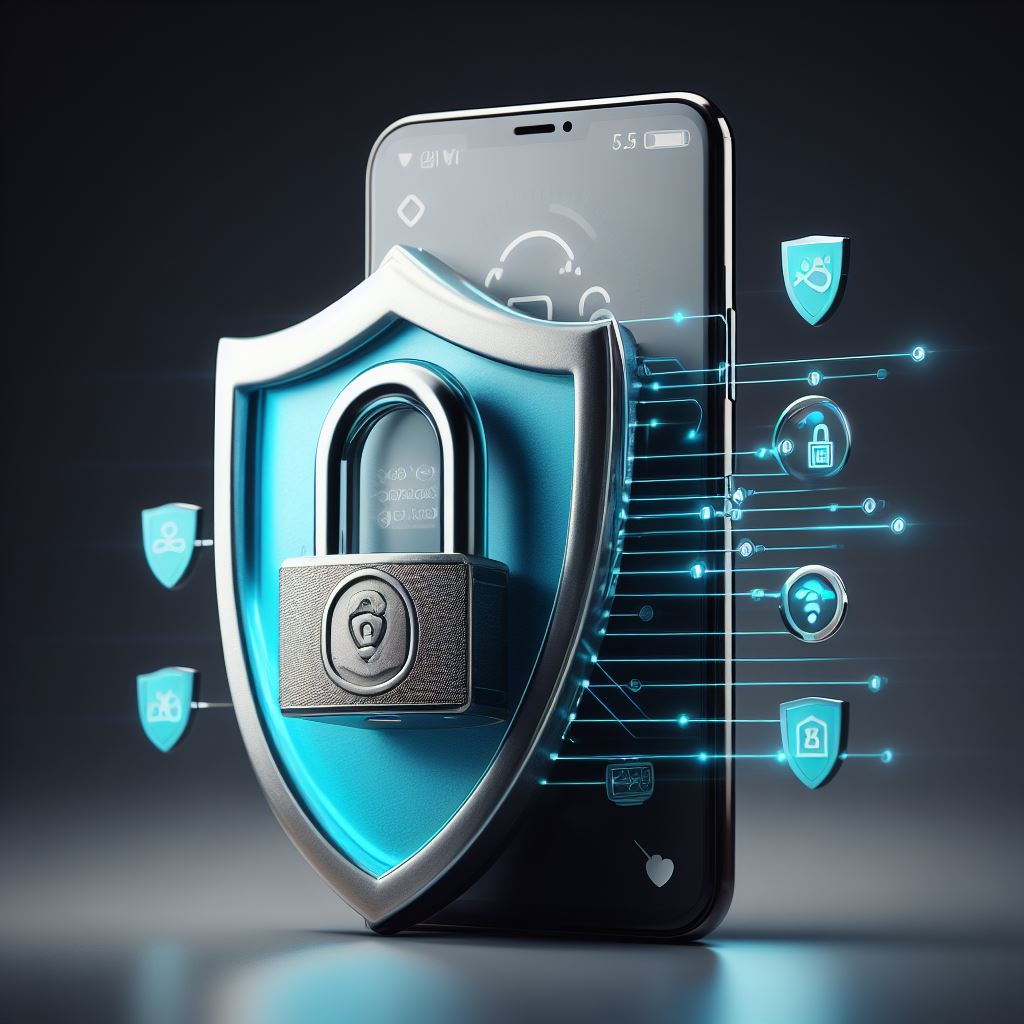12 Tips to Secure Your Q Link Wireless Free Plan

Are you ready to fortify your Q Link Wireless free plan? Follow these 12 tips to lock down your device and protect your sensitive information.
- Strengthen your passwords.
- Activate two-factor authentication.
- Keep your software up to date.
Don’t forget to enable device encryption and stay alert for phishing attempts.
- Enable device encryption.
- Stay alert for phishing attempts.
Regularly back up your data, install antivirus software, and secure your social media accounts.
- Regularly back up your data.
- Install antivirus software.
- Secure your social media accounts.
With remote tracking and wiping enabled, you can ensure your Q Link Wireless free plan stays safe and secure.
Key Takeaways
- Use a strong password with a combination of uppercase and lowercase letters, numbers, and symbols for your Q Link Wireless Free Plan account.
- Enable two-factor authentication for added security and protection against unauthorized access to your Q Link Wireless Free Plan account.
- Regularly update your device’s software and operating system to patch vulnerabilities and address security issues.
- Avoid using public Wi-Fi networks and consider using a VPN to encrypt your internet connection when accessing your Q Link Wireless Free Plan account.
Strong Passwords
To ensure the security of your Q Link Wireless Free Plan, use a strong password. A strong password is essential in protecting your personal information from unauthorized access.
When creating a password, follow these guidelines to maximize its strength. First, make sure your password is at least eight characters long. The longer the password, the harder it’s for hackers to crack. Include a combination of uppercase and lowercase letters, numbers, and symbols to make it more complex. Avoid using easily guessable information like your name, date of birth, or phone number. Instead, opt for a random series of characters that’s difficult to guess.
Additionally, refrain from using the same password for multiple accounts. If one account is compromised, it can put all your other accounts at risk. Remember to periodically change your password to further enhance security.
Two-Factor Authentication
Implementing two-factor authentication can greatly enhance the security of your Q Link Wireless Free Plan. Two-factor authentication adds an extra layer of protection by requiring you to provide two forms of identification before granting access. This helps increase security because even if someone manages to obtain your password, they won’t be able to access your account without the second factor of authentication, such as a unique code sent to your mobile device.
Another benefit of two-factor authentication is protection against unauthorized access. By implementing this security measure, you significantly reduce the risk of unauthorized individuals gaining access to your Q Link Wireless Free Plan. This ensures that only you can log in to your account, even if your password is compromised.
In addition to increased security and protection against unauthorized access, two-factor authentication also provides peace of mind. Knowing that your Q Link Wireless Free Plan is better protected against potential security breaches can give you peace of mind. It adds an extra layer of security to safeguard your personal information and sensitive data.
Keep Software Up to Date
Make sure to regularly update your software for optimal security of your Q Link Wireless Free Plan. Keeping your software up to date is crucial in safeguarding your devices and personal information. Software updates often include patches that fix vulnerabilities and address security issues. By staying current with the latest software versions, you ensure that you have the most up-to-date protection against potential threats.
Updating your software is a simple process that can be done in just a few steps. Most devices have an automatic update feature that can be enabled to download and install updates automatically. Alternatively, you can manually check for updates by accessing the settings or preferences menu of your device’s operating system or specific applications. It’s important to note that not only should you update the operating system itself, but also all the applications and programs you use regularly.
Neglecting to update your software can leave your devices susceptible to malware, viruses, and other security breaches. Hackers are constantly finding new ways to exploit vulnerabilities in outdated software, so it’s essential to stay proactive in ensuring the security of your Q Link Wireless Free Plan. By regularly updating your software, you can minimize the risk of unauthorized access and maintain a secure digital environment.
Enable Device Encryption
To secure your Q Link Wireless free plan, enabling device encryption is crucial. Encryption ensures that your data is protected and unreadable to unauthorized individuals.
The good news is that implementing encryption on your device is simple and can be easily done through the settings menu.
Importance of Encryption
Ensure your device encryption is enabled to enhance the security of your Q Link Wireless free plan. Encryption is a crucial component of cybersecurity, as it protects your sensitive data from unauthorized access. By enabling device encryption, you can enjoy the following benefits:
- Shielding your personal information: Encryption safeguards your personal data, such as passwords, credit card numbers, and browsing history, preventing hackers from intercepting and exploiting them.
- Secure online transactions: When making online purchases or accessing financial accounts, encryption creates a secure connection, ensuring that your sensitive information remains private.
- Protecting your privacy: Device encryption ensures that even if your device is lost or stolen, your data remains inaccessible to unauthorized individuals.
By enabling device encryption, you can significantly enhance the security of your Q Link Wireless free plan and safeguard your personal information.
Now, let’s move on to the next section to explore easy encryption implementation.
Easy Encryption Implementation
You can easily enable device encryption to enhance the security of your Q Link Wireless free plan.
Device encryption is a security feature that protects your data by converting it into an unreadable format. By enabling this feature, you ensure that even if someone gains unauthorized access to your device, they won’t be able to access your sensitive information.
To enable device encryption, go to your device’s settings, locate the security or privacy section, and look for the encryption option. Once you enable it, your device will start encrypting all the data stored on it, including your Q Link Wireless free plan details.
It’s important to note that enabling device encryption may slightly impact your device’s performance, but the added security is worth it.
Be Wary of Phishing Attempts
When it comes to securing your Q Link Wireless free plan, it’s important to be cautious of phishing attempts. Spotting phishing emails is crucial in order to protect your personal information from falling into the wrong hands.
Additionally, it’s essential to avoid fraudulent websites that may try to deceive you into providing sensitive data.
Spotting Phishing Emails
Beware of suspicious emails that may attempt to deceive you into providing personal information or clicking on harmful links. Phishing emails are designed to trick you into thinking they’re from a legitimate source, such as your email provider or a trusted organization.
To help you spot these malicious emails, here are some key signs to look out for:
- Poor grammar or spelling mistakes in the email content.
- Requests for personal information, such as your username, password, or financial details.
- Urgent or threatening language that creates a sense of panic.
Protecting Personal Information
To better protect your personal information, it is important to remain vigilant against phishing attempts, which can be frequent and deceptive. Phishing is a fraudulent practice where cybercriminals impersonate legitimate organizations or individuals to trick you into revealing sensitive information such as passwords, credit card numbers, or social security numbers. They often do this through deceptive emails, text messages, or phone calls that appear to be from trusted sources. To help you identify phishing attempts, here are some red flags to watch out for:
| Red Flags | Description |
|---|---|
| Suspicious sender | Emails or messages from unknown or suspicious email addresses or phone numbers. |
| Urgent requests | Messages that create a sense of urgency and pressure you to act quickly. |
| Misspellings and grammatical errors | Poorly written content with spelling mistakes and grammatical errors. |
| Suspicious links or attachments | Emails or messages that contain suspicious links or attachments. |
| Requests for personal information | Messages that ask for personal or financial information, even if it seems legitimate. |
Avoiding Fraudulent Websites
To protect your personal information from phishing attempts, it’s important to be cautious and aware of fraudulent websites. Here are some tips to help you avoid falling victim to these scams:
- Look for secure websites that start with ‘https’ and have a padlock symbol in the address bar.
- Be wary of emails or messages asking for your personal information, such as passwords or credit card details.
- Double-check the website’s URL before entering any sensitive information to ensure it matches the legitimate site.
By being vigilant and following these precautions, you can safeguard your personal information from phishing attempts and avoid falling prey to fraudulent websites.
Now, let’s move on to the next section about avoiding public Wi-Fi networks, which pose another security risk.
Avoid Public Wi-Fi Networks
Protect your Q Link Wireless Free Plan by steering clear of public Wi-Fi networks. While these networks may seem convenient, they pose significant security risks. Hackers can easily intercept your data and gain access to your personal information, putting your Q Link Wireless Free Plan at risk. To understand the dangers of public Wi-Fi networks, take a look at the table below:
| Risks of Public Wi-Fi Networks | Ways to Protect Yourself |
|---|---|
| 1. Man-in-the-Middle Attacks | 1. Use a Virtual Private Network (VPN) to encrypt your internet connection. |
| 2. Rogue Networks | 2. Confirm the network’s legitimacy with the establishment or use your mobile data instead. |
| 3. Malware Infections | 3. Keep your device’s antivirus software up to date and avoid clicking on suspicious links or downloading unknown files. |
| 4. Eavesdropping | 4. Limit your online activities on public Wi-Fi networks and avoid accessing sensitive information. |
Use a VPN
To ensure the security of your Q Link Wireless free plan, it’s recommended that you use a VPN.
A VPN, or Virtual Private Network, provides online security and privacy by encrypting your internet connection and routing it through a server.
With a VPN, you can protect your sensitive information from hackers and maintain your anonymity while browsing the internet.
VPN for Online Security
Secure your Q Link Wireless Free Plan by utilizing a VPN for enhanced online security. A VPN, or Virtual Private Network, creates a secure and encrypted connection between your device and the internet.
Here are three benefits of using a VPN for online security:
- Protection of sensitive information: A VPN encrypts your data, making it unreadable to hackers and ensuring that your personal information remains secure.
- Anonymity and privacy: By masking your IP address, a VPN allows you to browse the internet anonymously, preventing websites and advertisers from tracking your online activities.
- Safe browsing on public Wi-Fi: When connected to a public Wi-Fi network, using a VPN ensures that your data is protected from potential threats, such as hackers or snooping individuals.
By using a VPN, you can enhance the security of your Q Link Wireless Free Plan and protect your online activities.
Now let’s delve into the importance of privacy with a VPN.
Privacy With VPN
Enhance your online privacy with a VPN, ensuring that your Q Link Wireless Free Plan remains secure and your personal information stays protected.
A VPN, or Virtual Private Network, creates a secure encrypted connection between your device and the internet. When you connect to the internet through a VPN, your data is encrypted, making it nearly impossible for anyone to intercept or access your information.
This is particularly important when using public Wi-Fi networks, as they’re often vulnerable to hackers and cybercriminals. By using a VPN, you can browse the internet anonymously and hide your real IP address, making it difficult for anyone to track your online activities.
Additionally, a VPN can also help you bypass geographical restrictions and access content that may be blocked in your region.
Choose a reliable VPN service provider to ensure the highest level of privacy and security for your Q Link Wireless Free Plan.
Disable Automatic Wi-Fi Connections
By disabling automatic Wi-Fi connections, you can ensure the security of your Q Link Wireless free plan. This simple step can protect your sensitive information from potential threats. Here are three reasons why it’s important to disable automatic Wi-Fi connections:
- Prevent unauthorized access: When your device automatically connects to any available Wi-Fi network, it may connect to unsecured or malicious networks without your knowledge. By disabling automatic connections, you have control over which networks you connect to, reducing the risk of unauthorized access to your data.
- Avoid man-in-the-middle attacks: Automatic Wi-Fi connections can make you vulnerable to man-in-the-middle attacks, where an attacker intercepts your communication and steals your personal information. Disabling automatic connections ensures that you’re aware of the network you’re connecting to and can verify its security before transmitting any sensitive information.
- Protect against Wi-Fi phishing: Hackers can create fake Wi-Fi networks that mimic legitimate ones to trick users into connecting and providing their personal information. By disabling automatic connections, you can prevent falling victim to such phishing attempts and protect your Q Link Wireless free plan from potential fraud.
Taking the time to disable automatic Wi-Fi connections is a simple yet effective way to enhance the security of your Q Link Wireless free plan.
Regularly Back Up Your Data
To ensure the continued security of your Q Link Wireless free plan, it’s important for you to regularly back up your data.
Backing up your data is crucial because it protects your information from loss or damage. Imagine if your phone were to get lost, stolen, or damaged beyond repair. All of your important files, contacts, and photos could be gone forever. By regularly backing up your data, you can avoid this nightmare scenario.
There are several methods you can use to back up your data.
One option is to use cloud storage services such as Google Drive or Dropbox. These services allow you to store your files securely in the cloud, accessible from any device with an internet connection.
Another option is to use an external hard drive or a USB flash drive. Simply connect the device to your computer and copy your important files onto it.
It is recommended that you back up your data at least once a week. This will ensure that you always have a recent copy of your information in case of any unexpected events.
Additionally, it’s a good idea to create multiple backups and store them in different locations. This way, if one backup gets lost or damaged, you still have another copy to rely on.
Regularly backing up your data is a simple yet effective way to safeguard your Q Link Wireless free plan. It only takes a few minutes of your time, but it can save you from a lot of stress and frustration in the long run.
Install Antivirus Software
To further protect your Q Link Wireless free plan, it’s crucial that you install antivirus software on your device. Antivirus software is designed to detect, prevent, and remove malicious software, such as viruses, worms, and Trojans, that can compromise the security of your device and your personal information.
Here are three reasons why installing antivirus software is essential:
- Protection against malware: Antivirus software scans your device for known malware and prevents it from infecting your system. It constantly updates its virus definitions to stay up-to-date with the latest threats, ensuring comprehensive protection.
- Real-time threat detection: Antivirus software actively monitors your device for any suspicious activity, such as unauthorized access or malicious software attempting to install itself. It alerts you immediately and takes necessary actions to prevent any potential damage.
- Safe browsing experience: Antivirus software includes features like web protection that help you browse the internet securely. It blocks malicious websites and prevents you from clicking on dangerous links, reducing the risk of falling victim to phishing attacks or downloading malware unknowingly.
Secure Your Social Media Accounts
Protecting your Q Link Wireless free plan also involves ensuring the security of your social media accounts. Social media platforms are increasingly being targeted by hackers, making it crucial to take measures to safeguard your accounts. Start by enabling two-factor authentication (2FA) on all your social media profiles. This adds an extra layer of security by requiring a verification code in addition to your password. Regularly update your passwords and use strong, unique combinations that include a mix of letters, numbers, and special characters. Avoid using common phrases or personal information that can be easily guessed.
Be cautious of the information you share on your social media accounts. Avoid posting sensitive personal details, such as your full name, address, or phone number, as this information can be exploited by cybercriminals. Additionally, review your privacy settings to control who can see your posts and personal information.
Beware of phishing attempts on social media platforms. Hackers may try to trick you into revealing your login credentials or personal information through fraudulent messages or links. Always verify the authenticity of messages and avoid clicking on suspicious links.
By securing your social media accounts, you can minimize the risk of unauthorized access and protect your personal information.
Now, let’s move on to the next section about enabling remote tracking and wiping to further enhance the security of your Q Link Wireless free plan.
Enable Remote Tracking and Wiping
How can you enhance the security of your Q Link Wireless free plan? One important step is to enable remote tracking and wiping. By doing so, you can have greater control over your device and protect your personal information.
Here are some ways to enable this feature:
- Activate Find My Device: This built-in feature allows you to track the location of your device in case it gets lost or stolen. You can access it through your Q Link Wireless account settings.
- Set up Remote Lock: With this feature, you can remotely lock your device to prevent unauthorized access. It ensures that even if someone finds your device, they won’t be able to use it without your permission.
- Enable Remote Wipe: In case your device is irretrievable or falls into the wrong hands, remote wipe allows you to erase all the data on your device remotely. This ensures that your personal information remains secure and can’t be accessed by anyone else.
Frequently Asked Questions
Can I Use My Q Link Wireless Free Plan on Multiple Devices?
Yes, you can use your Q Link Wireless free plan on multiple devices.
What Should I Do if I Suspect My Q Link Wireless Account Has Been Compromised?
If you suspect your Q Link Wireless account has been compromised, take immediate action. Change your password, contact Q Link Wireless customer support, and monitor your account for any unauthorized activity.
Are There Any Additional Fees or Charges Associated With the Q Link Wireless Free Plan?
There aren’t any additional fees or charges associated with the Q Link Wireless free plan. It’s completely free and provides essential services like calls, texts, and data. You can enjoy these benefits without worrying about extra costs.
How Can I Protect My Personal Information When Using Public Wi-Fi Networks With My Q Link Wireless Free Plan?
To protect your personal information when using public Wi-Fi with your Q Link Wireless Free Plan, use a VPN, avoid accessing sensitive information, and ensure your device’s security settings are up to date.
What Steps Can I Take to Ensure the Security of My Q Link Wireless Free Plan While Traveling?
To ensure the security of your Q Link Wireless free plan while traveling, take these steps: use a strong, unique password, enable two-factor authentication, update your device’s software regularly, and avoid connecting to unsecured public Wi-Fi networks.



